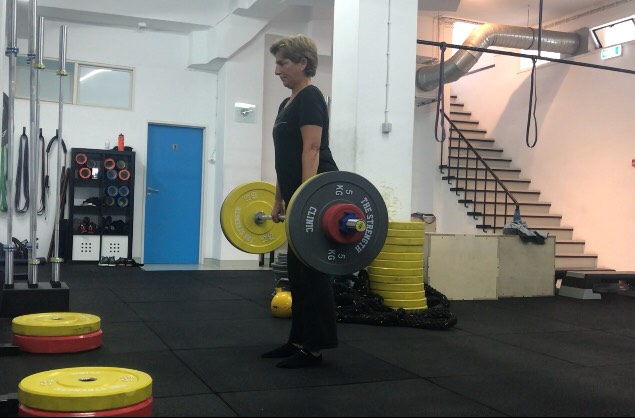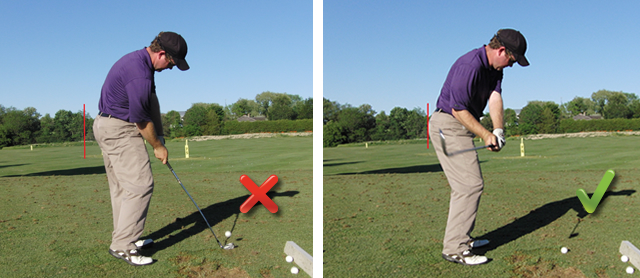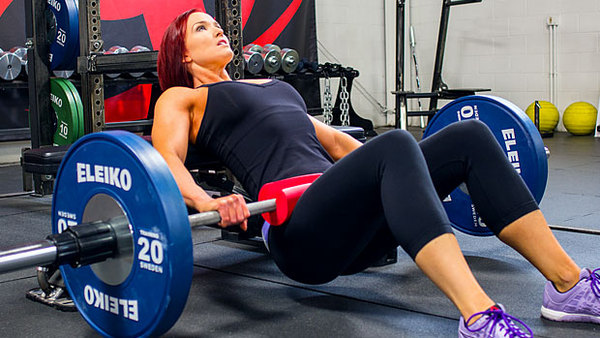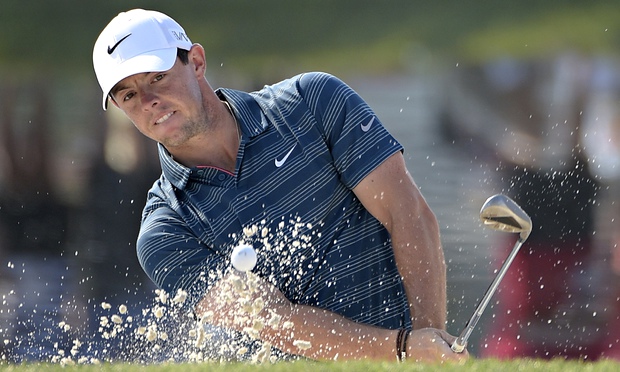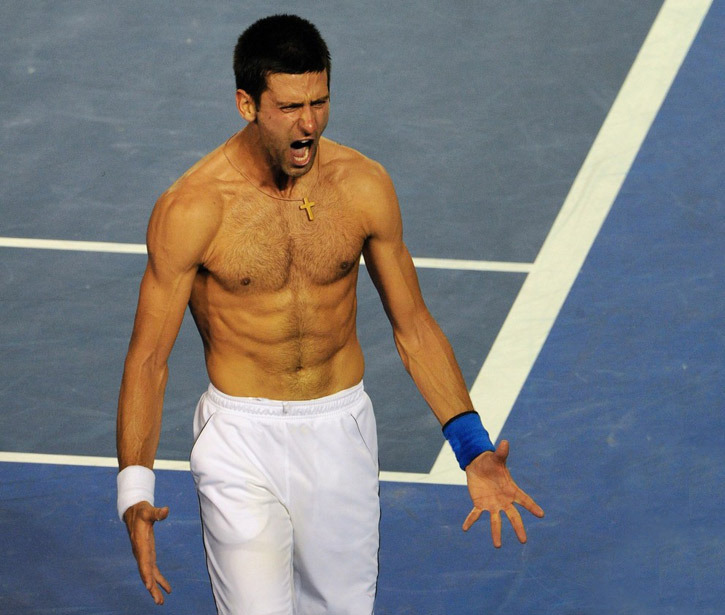Strength training has been recognized as the strategy of choice to stay more functional and live longer. The benefits of strength training are in fact ubiquitous and positively affect the various biological systems that tend to decline with age, namely systems related to neuromuscular, cardiovascular and cognitive functions.
It has been observed that strength training programs in which the included exercises are performed at higher intensities (> 80% of maximum intensity) or with lighter loads but performed explosively tend to produce better results compared to training protocols where exercises are performed at lower intensities and / or non-explosively (Mendonça et al., 2016a). The magnitude of the load used (i.e. heavy or lighter but performed explosively) are especially relevant for older populations. Why? Because aging is associated with the loss of Type II muscle fibers, which are responsible for producing maximal strength (e.g. lifting a weight and not being able to lift it again in the next minutes or hours) or as explosive strength (e.g. moving an object or your own bodyweight at maximal speed). Now, the overwhelming majority of daily life movements are ballistic in nature (i.e. fast, short duration movements) and often for the purpose of moving relatively heavy objects for a short period of time. Therefore, it is not surprising that a training program that includes exercises that imply moving heavy loads and / or loads moved explosively is more effective in “preparing” people for everyday activities.
Training at higher intensities in a training program based on fundamental movement patterns (squatting, pushing, pulling, loading and lifting objects off the ground) makes people less vulnerable to falls and “tweaks”, and at the same time more able to recover from such incidents should they occur.
Train hard and smart! A structured training program that respects the principle of progressive overload is more valuable than a program that always keeps you within the comfort zone. Be as active as you can get during the day but IF TRAINING AT GYM DO NOT WASTE YOUR TIME, AND REALLY TRAIN! Seriously, it works!
Good lifting! ?
References
Mendonca, G. V. et al., 2016a. Impact of Exercise Training On Physiological Measures of Physical Fitness in the Elderly. Current aging science, 9(3).
Following up on the topic addressed in the last article, let’s talk today about a common swing characteristic that affects a lot of golfers and that can compromise their swing efficiency and their performance on the golf course: Early Extension.
What is Early Extension?
Early extension can be understood as an integral part of loss of posture, this happens when the player’s hip and spine begin to extend too early in the downswing, i.e. the hips and pelvis move towards the ball in the downswing. In practical terms, if your body is not prepared to perform an efficient golf swing while maintaining good posture throughout the movement, you will end up lifting the upper body (spine) and miss the necessary hip rotation at impact. Your hips play a key role in injury prevention and performance improvement. If you have poor hip mobility, sooner or later your lower back will complain (and you can be sure that this situation will not be very pleasant).
According to studies conducted by the Titleist Performance Institute, 64.3% of amateur golfers early extend
Players who early extend usually refer that they feel trapped during the downswing as if they had to shrug their arms to hit the ball. And it’s normal for that to be so because when you extend your hips too early on the downswing, the space that was supposed to be occupied by your arms and hands was occupied by the lower body. Therefore, the end result will be a blockage of the movement, since your arms and hands can’t get out of the way and will still be needed to hit the ball.
How can I diagnose?
An easy and simple way to check if you do early extension is with your Smart Phone (you probably already have applications that allow you to draw lines and analyze your swing). All you need to do is to ask a friend to film you in the direction of the swing line and capture its full motion from the starting position (setup). After having your swing recorded, compare the position of your pelvis in the initial position with the position of the pelvis in the position of impact, if you notice that it moved towards the direction of the ball is because you extended your hip too early. If this is not possible, you can always ask your golf teacher to help you, I am sure he will be happy to do that.
What are the physical limitations?
“If you’re not assessing, you’re just guessing” – Greg Rose
The physical limitations can be many and to determine the causes that are affecting you, it would be important to make a functional assessment with a professional who understands how your body should move and its relation to the golf swing. According to what I have observed in my practice, I would like to highlight the following:
- Limitations on performing a full squat with the arms extended overhead;
- Limitations in hip mobility (especially in internal rotation of the leading hip and in anterior or posterior pelvic tilt);
- Limitations in the ability to separate / disassociate the thorax from hips (X factor);
- Limitations in the ability to stabilize the pelvis because the glutes and core muscles are inhibited.
What can I do to improve?
Although the causes may vary from person to person, I’m pretty sure that if you do the following exercises, you will improve and increase your body’s functionality to play golf for a longer time. You only need 10 minutes a day.
- Myofascial Release with Roller Stick
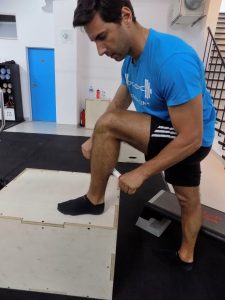
Using a roller stick, look for the trigger points of your calf and massage the inner, central and outer sides of the muscle for 30 seconds in each area. The points that hurt you most are those that need more care. Yes, this exercise might be a little uncomfortable but it’s worth it.
- Glute Bridge with Leg Extension
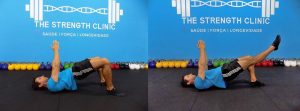
Lying in the supine position, push your heels against the floor, tighten your glutes, and raise your hips to form a glute bridge, with your arms up. Once in this position, extend one leg and form a straight line between the shoulder, hip and heel. Hold this position for 20-30 seconds, always keeping your hips high. Change legs and repeat 5 times on each side.
- Squat with Overhead Arm Reach
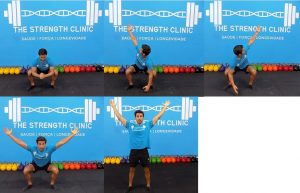
In the squat position (with your heels on the floor and your knees out), raise one arm up, lift the other arm (always looking at your hand) and then raise both arms at the same time and return to the standing position. If you can not squat without raising your heels, you can use a rolled up towel or a board to keep your heels high. Do 2-3 sets and repeat 8-10 times.
- Assisted Squat wiht Medicine Ball
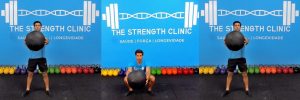
In the standing position, with your feet shoulder-width apart and slightly rotated out, hold a medicine ball (or a bucket full of balls) in front of your body, and begin to slowly lower your body into the squat position by keeping your back straight and without lifting your heels off the floor. Do 2-3 sets and repeat 10-12 times.
I believe that these exercises can be helpful to you, but remember: The swing you can do is directly related to what your body is prepared to do.
See you soon!
Pedro Correia
“Do not judge a man’s strength by the size of his biceps. Things do not always look what they seem.”
– Pavel Tsatsouline
In my opinion a normal human being should aim to be strong. And when I say strong, I’m not talking about those bulked individuals with a strange gait. Anyone (of any age) can become stronger by working consistently for this. Unfortunately, most people are more WILLING to be strong than doing what they need TO DO to be strong. Yes, these are different things. And yes, it’s not easy. One thing is WANTING a top-of-the-range Porsche, another thing is DOING the things needed to have a top-of-the-range Porsche. With strength is the same situation. To be strong, you need to have a plan (or have someone design a plan for you) and to work consistently to execute that plan – this is what your objective should be: to execute the plan. That’s it. You do not become what you THINK about every day, you become what you DO every day. Yes, there are no miracles, no one gets stronger without effort and without spending the time necessary for that to happen. The fitness magazines and the marketing associated with this industry want to make you believe that it’s possible to get stronger or leaner without great effort and quickly. It’s because of these kinds of messages that people still believe in shortcuts and / or allude to the power of genetics. They want it all but they don’t do anything (nothing useful at least). And then they still blame genetics!
There is one thing you should be aware of right now, strength is a skill. And in this sense, strength is the ability to generate more tension in muscles. And that is why strength is the basis for the development of speed, endurance and even flexibility. Like all skills, there are techniques or more appropriate ways to develop it. And that’s what I’m going to share with you. I will teach you some techniques for you to get stronger faster but this will only work if you apply them consistently in training. So, do them! Some of these techniques have already been used with me and with my clients / athletes, so I can assure you that they work and that they are scientifically proven, if that interests you as well. And before explaining them, I want to refer to Pavel Tsatsouline (I love reading his books), since he has been one of the individuals who has shared most of the “Russian secrets” of strength and one of the persons who have inspired me most in this journey. I hope I can meet him someday. Ready? Let’s do it!
- Irradiation
This one is easy, this one any five-year-old understands.
First make a bicep curl set of 5-6 repetitions with good form, keeping the elbow close to the body and without tilting the trunk back. You can use a dumbbell or a barbell. But a serious dumbbell, it’s not worth using Barbie and Ken-style dumbbells, let these tools for people to have fun in aerobic classes! After doing this set, rest for a few minutes and make the following changes: before doing the movement again, i) squeeze hard the dumbbell or barbell; (ii) squeeze your glutes as if you wanted to crack a nut with your buttocks and (iii) tighten your abs and imagine that Mike Tyson will punch you in the stomach.
If you can do these three things, you will realize that the weight will get lighter and you will be able to do a few more reps – in a better and safer way. The explanation is this: when you create tension at various points in the body this will increase total body stability (via the neural impulses produced by the contracting muscles) and this stability / force will irradiate (i.e. spread) to the neighboring muscles as if it were an electric current to start the engine. And the most interesting part lies on the fact that the strength of a particular muscle, for example the bicep, can be amplified if the neighboring muscles also help! Have you realized why in the union lies strength? The formula is simple: more tension = more stability = more force.
- Bracing
Who still does arm wrestling in school? I perfectly remember the times when I was in school and this was one of the games we did in during class breaks or when we had a hole in our schedule. I remember very well the agonizing look of my classmates when they were about to be defeated or their expression of jubilation when I let them gain advantage and then finished strong. Yes, this was fun at the time! And yes, most of the time I won ?.
I gave the example of arm wrestling because I think this is the best way to understand this phenomenon. Lets’ see: an individual who can generate more tension before squeezing his opponent’s hand will have a superior neuromuscular activation level and a clear advantage over an individual who only begins to squeeze when someone (the referee) gives the signal to begin the “combat”. According to Prof. Yuri Verkhoshansky, if we create a sort of pre-tension in the muscles before starting a dynamic contraction, this can lead to increases of up to 20% in performance! Now imagine the advantage you can have if you can apply this technique and if your opponent does not know about it.
Try this technique as follows. Do five normal push-ups and relax on the floor between reps. Then do another five and this time think about creating tension in the whole body, that is, think of squeezing your glutes and abs before pushing against the floor to come up. If you do this well, you will realize that you are much stronger than you thought. Therefore, the key to this technique is in creating tension in the whole body before counteracting resistance. If you do not create this tension before, you will remain weak. Do not be that person.
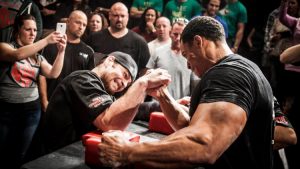
- Power Breathing
First, a few notes on breathing. Proper breathing is very important to maximize performance, a normal person breathes on average more than eight million times a year and it is more likely that he will not do it efficiently. If there was a movement pattern that you had to repeat 23,000 times a day, would you not make an effort to improve it? Think about this a little bit. Most people only use a small percentage of the body’s ability to extract oxygen from the air into the lungs because they tend to breathe only with the upper body (apical breathing), instead of breathing deeper by using the most efficient respiratory muscle we have, the diaphragm (I think we do not talk much about the diaphragm in fitness / bodybuilding magazines because this is an invisible muscle that will not really impress women). But the fact is that this daytime breathing will affect several things: your recovery ability, your anatomical structure, the functioning of your autonomic nervous system, and your cognitive ability. So, if we are talking about performance optimization, be sure to improve your breathing patterns as well.
Second, regarding power breathing, this technique consists of holding the breath during the various phases of lifting. For example, the legendary Bruce Lee used to say that in the martial arts the power of breathing was more important than body strength. In general, the effect of breathing patterns and intra-abdominal and intra-thoracic pressure on strength is strangely ignored or misunderstood by fitness professionals and some medical authorities. These authorities seem to forget that orthopedic injury is much more common than cerebrovascular injury. That traditionally taught breathing pattern of inhaling when we lower the weight (eccentric phase) and exhaling when we raise the weight (concentric phase) may be useful in some cases (and we can’t say that’s wrong) but it’s not the one you want to do when you want to generate as much tension / strength as possible in the muscles. Why? Because the increase in intra-abdominal and intra-thoracic pressure will boost muscle excitability (through the pneumo-muscular reflex) and it is this process that will guarantee more stability in the spine and that will amplify your strength. This is the most natural way to produce strength! Yes, your fitness instructor may have said that forced exhalation of air against the glottis (i.e. the Valsalva maneuver) is hazardous to your health and that you may have a stroke doing this. But is this assertion correct? Prof. Yuri Verkhoshansky and Dr. Mel Siff, two of the world leading authorities on strength training, say the following in this regard in the book Supertraining, one of the strength training bibles:
“For example, the Valsalva maneuver associated with holding breath has a vital role in increasing intra-abdominal pressure to support and stabilize the lumbar spine during heavy lifting… It has been corroborated on many occasions that stress on the spine is decreased during any movement against high resistance and that exhalation during lifting increases the risk of injury to the lumbar spine. Thus, it is unwise to follow popular medical advice that people must exhale during the effort”. The authors further add: “while this may be appropriate for patients with heart disease or hypertension, this same action performed by an athlete who is doing squats or heavy lifting overhead, can seriously compromise spine stability and safety”.
Got it? This means that any healthy person can and should apply this technique if they aim to get stronger and lift heavy loads in a safe way. People with hypertension and heart disease should be more cautious in this regard but please note: this is not to say that they can’t strength train, there are many other ways to develop strength. By the way, it is already well documented in the scientific literature that these people can and should do strength training to improve their condition!
- Successive Induction
Successive Induction, such as the Law of Irradiation we have seen above, is another of the Sherrington Laws exploited to the maximum by the Russians. According to this law, contraction of a muscle – for example, the triceps – will make your muscle antagonist – in this case, the biceps – stronger than normal. In the early 1980s scientists suggested that this technique had a disinhibiting effect and later confirmed that a strength training program that included pre-tensioning an antagonist muscle (i.e. successive induction) was more effective than a program of conventional training. And the most interesting thing is that these benefits were not only limited to an acute performance increase, but also resulted in long lasting strength improvements.
Do the following test. Grab a barbell or free weight and get ready to make a bicep curl set with a load that allows you to do 5-6 solid repetitions. Remember, hold your elbows close to your body and do not lean your trunk back. Do one set and count the number of repetitions you can do with good form. After resting for a few minutes, keep the same weight and do another set, but this time using this new technique. When you bring the weight up, apply the other techniques you already know (irradiation and bracing) and on the descent apply the technique of successive induction, “pulling” the weight down with the triceps. In this way, you will give the biceps some rest on the descent (by preventing them from locking the movement) and will allow the triceps to also have a more active participation in the movement. You should expect to be able to do one or two more reps this way!
Therefore, when applying this technique, you will have two engines controlling the movement. And because of the co-contraction of both muscle groups, this technique may also offer greater benefits in terms of joint stability since the stress on them will be reduced (note: do not forget to discuss this with your doctor if you have joint problems).
Finally, my advice to you is this: if you want to start lifting heavy loads safely begin applying these principles in training (if you can’t do this alone ask someone you know to help you) and enjoy learning one of the skills (i.e. strength) you will need most to optimize your health. And be patient, do not expect to learn all these things from one day to another – it takes time and practice, good practice of course.
See you soon!
Pedro Correia
References
Tsatsouline, P. (1999). Russian Strength Training Secrets for Every American. Dragon Door Publications.
Tsatsouline, P. (2003). The Naked Warrior. Master Secrets of the Super Strong – Using Bodyweight Exercises Only. Dragon Door Publications.
Verkhoshansky, Y; Siff, M.; (2009). Supertraining. Sixth Edition – Expanded Version. Ultimate Athlete Concepts.
Verstegen, M.; Williams, P. (2014). Every Day is Game Day. Penguin Group.
“We don’t believe there is one way to swing a club; we believe there is an infinite number of ways to swing a club. But we do believe there is one efficient way for all golfers to swing a club and it is based on what they can physically do.”
– Titleist Performance Institute
If you’re reading this, you’re probably interested in improving your physical condition to make more birdies, hit longer drives, and increase your longevity as a golfer. Or, perhaps, your goal is to become the best player in your club or win the next Match Play Championship. No matter what your motivation is, the fact is that if your goal is to improve your game, this will require you to prepare yourself a bit better than most golfers I know. And better does not necessarily mean training longer hours!
If you´re still one of those players who spends hours and hours hitting buckets of balls on the driving range hopping that this will help you improve your golf game, you need to change your strategy. Hitting buckets of balls in the driving range and making chips and putts is not enough. If you truly want to improve your performance in this sport, your practice needs to include general athletic development exercises and specific physical training for golf, in a progressive and periodized manner.
This means that what you normally see in the gym has nothing to do with what you need to do to hit farther, straighter and to go through the 18 holes without getting so tired.
First: Is your swing efficient?
The only way to determine whether your golf swing is efficient or not is through a 3D Biomechanical Analysis. What we can see in the traditional video imaging used by most golf professionals / teachers is just the swing style. There are many golfers who do not have a particularly attractive swing (e.g. Raymond Floyd, Jim Furyk or John Daly) but the reason why these players were or are successful is because their swing is efficient. Having an efficient swing for a golfer means transferring energy (without leaks) through the feet, knees, hips, spine, shoulders, arms, wrists down to the club head and ultimately to the ball. With the data obtained through the 3D system, we can check the kinematic sequence of each player, that is, we can measure the speed of rotation of each body segment involved in the execution of the golf swing and determine if each segment is accelerating and decelerating correctly.
When we look at Jim Furyk and Ernie Els swing through video analysis (and through the naked eye), we can see that both swings are quite different from each other, however, when we look at the kinematic sequence of each player, we find that it’s difficult to see a significant difference between the two swings. This means that although Ernie Els and Jim Furyk have completely different swing styles, they both share the same kinematic sequence.
All great players start by generating speed from the hips and transferring that energy through the torso, arms and club. This is the efficient sequence in the downswing.
The golf swing is a complex multi-dimensional movement that involves a highly coordinated action of the entire kinetic chain (feet, knees, hips, spine, shoulders, arms and wrists) and takes less than two seconds. The golf swing is therefore a ballistic movement which, in order to perform efficiently (i.e. with a correct kinematic sequence), it’s necessary that the various body segments are properly prepared to deal with the inherent shear and rotation forces in this movement. Hence the importance of what follows.
Second: The Physical Assessment in Golf
Before we get to the physical training itself, it’s important to know what your physical limitations and asymmetries in terms of movement are (one of the main causes of injury). Because of this, it’s essential that you perform a functional assessment for golf, preferably with a qualified professional that knows what he’s doing. In the same way that you go to the doctor for exams to find out how your health markers are, you should also do an initial assessment with a golf fitness specialist to find out how your body behaves during a golf swing and which are the main limitations / compensations.
The physical evaluation in golf consists of performing several tests in order to measure the functionality of the body movement patterns necessary for golf, that is, the measurement of various indicators of its stability, mobility, balance and various performance parameters such as strength, power and cardiovascular capacity.
This type of assessment is the starting point for playing better and for preventing injuries. If you still think that your body is fine and that you don’t need any intervention at this level, you’re more likely to be wrong. Our body was not designed to lead the way we live today, so you can be pretty sure there are things in your body that need some work. If you still do not believe me, think of golfers you know who have never complained of back pain or pain in another part of the body (wrists, shoulders, elbow).
Your body is the determining piece of equipment in your game. The quality of the clubs, balls, gloves, shoes and the latest drive or putt on the market, are certainly not the most important aspects. I still see many golfers too preoccupied with the new gadgets and the style of clothing, when in fact these are not the most important things to get more birdies. What will, in fact, bring you better results is improving your body’s functional skills to hit the ball more efficiently and safely.
Final Remarks
Many players fail to perform an efficient golf swing not only because the movement itself is complex but also because their bodies are not properly prepared to deal with the forces generated during the movement.
Keep this in mind the next time you hit balls or have a lesson with your golf teacher, maybe that’s why you can’t do what your teacher asks you to do. There is no point constantly insisting on improving technique if there is no synergistic effort in improving physical skills. The swing you can perform is directly related to what your body is prepared to do – think of the golf club as an extension of your body.
In the next articles I will share the most common characteristics in this relationship between the body and the golf swing and suggest some exercises so that you can improve your performance on the golf course.
Stay tuned!
Pedro Correia
Whatever the sport, strength training, in harmony with various training factors (i.e., technical, tactical, physical and psychological) and training principles (i.e., overload, specificity, reversibility, heterochronism, specialization, continuity, progression, cyclicity, individualization and multilateralism) will endow the athlete with a complete set of tools in order to maximize performance.
In tennis, strength is used to generate speed, power and endurance. It is impossible to have agility, speed, power, a developed anaerobic system, and flexibility / mobility without optimal strength levels (Verstegen, 2003). Strength training is also critical to prevent injury. Because tennis is a sport that involves many repetitions of movements of unilateral features, it is conducive to developing muscular imbalances which significantly increase the likelihood of injury. In tennis, the highest incidence of injuries is in the shoulders and back, followed by injuries in the elbows, knees and ankles (Kibler & Chandler, 1994). Thus, specific strength training for tennis is essential to maintain or restore proper muscle balance.
Definition of Force
The definition of force based on its purely mechanical concept consists of any cause capable of modifying the state of rest or motion of a body, consisting of a vector with a given magnitude and direction. It is the product of mass by acceleration (F=m*a). Although this definition of force is unanimously accepted, it hardly illustrates the different components of muscle strength. That is, if we understand muscle strength as an essential component for the development of motor skills which consists of the ability to apply force to overcome resistance (O’Sullivan & Schmitz, 1998).
Why Strength Training in Tennis?
A strength training program in the context of tennis should aim at developing “highly innervated muscles with an explosive ability” so that players can serve with greater speed, so that they can put “more weight” on the ball (due to an improved use of ground reaction forces), so that they can cover more area on court (because they are more agile and fast), and so that they feel as if they “float” on the court the whole day and week (Verstegen, 2003). It is important though to dispel some myths regarding strength training, namely that this type of training will make players slower, less agile or tight. Only poorly designed strength training programs will lead to this. In fact, several studies show that amongst Olympic athletes, weightlifters are those displaying the highest levels of power and are second best (after gymnasts) regarding flexibility levels (Jensen & Fisher, 1979).
It has been well established that adequate strength training not only maintains levels of flexibility but can actually significantly increase them (Fox, 1984; Jensen & Fisher, 1979; O’Shea, 1976; Rash, 1979). Also, adequate strength training induces significant improvements in: work capacity; body composition (i.e., lean mass gains and loss of fat mass); energy efficiency; tissue growth hormonal secretion profile favoring protein synthesis (e.g. strength training induces growth hormone secretion and testosterone); posture; and muscle balance (Lamb, 1984; Stone et al., 1982).
Specifically in tennis, it has been shown that strength training strengthens the immune system (thus protecting the player from injury and illness), and is often pointed to have a positive psychological effect on players, since it appears to be coupled with an increase in levels of self-confidence during matches (Folkins & Sime, 1981; Tucker, 1983), as out of the game (Folkins & Sime, 1981).
The Various Types of Strength and Its Application in Tennis
- Strength endurance: the ability to produce force over time while resisting to fatigue. Good strength endurance levels allow the maintenance of proper form and a correct technical execution. Together with the static strength, strength endurance makes a sort of a basis for developing other types of strength training in tennis.
- Static strength: the ability to stabilize joint structures allowing better transmission of energy along the kinetic chain, i.e. without loss of energy. In tennis, this type of strength allows optimal use of force generated against the ground to subsequently transfer speed to the ball.
- Maximal strength: relates to the maximal force value during a voluntary contraction against an immovable resistance. It is mainly a strength assessment parameter and we can consider its absolute and relative measures (i.e. relative to body weight). For tennis, relative strength is more relevant than absolute strength because it has a direct influence on the player’s speed and agility. Strength Deficit (SD) should also be evaluated based on measures for Maximum Eccentric Force (MEF) and Maximum Isometric Force (MIF). The SD = MEF-MIF. If the SD > 25% for the lower limbs, and SD > 50% for the upper limbs, training should prioritize Rate of Force Development (RFD). If below these values, strength training should focus on hypertrophic and maximal strength methods.
- Power – the ability to produce the most amount of force in the shortest time interval. It includes:
- Starting strength (up to 250ms of the force / time curve) –expressed as the Initial Force Production Rate (IFPR) and reveals the ability to accelerate from a static position (i.e., velocity = 0);
- Explosive force (above 250 ms of the force / time curve) – expressed as the Maximum Force Production Rate (MFPR) and reveals the ability to accelerate to maximum force levels. It is one of the main indicators of performance in tennis. It corresponds to the phase of maximum acceleration during a given movement;
- Reactive force – force produced during muscle’s stretch-shortening cycle (SSC). The use of the elastic and reflex properties of the muscle present in the SSC influences the IFPR and the MFPR. Reactive force training (i.e., using muscle’s SSC) may contribute to increased acceleration capacity, that is, increasing IFPR and the MFPR, and consequently gains in power.
- Optimal Strength (Verstegen, 2003): the combination of the types of strength described above according to aspects inherent to the player and his/her performance, such as: age; capacities; style of playing; stage of development; type of surface on which they will play.
Table 1 specifies the ideal characteristics of strength training in tennis for the various stages of development according to the Long-term Athletic Development model (Balyi & Hamilton, 1999).
| Table 1. | |||
| Age | Characteristics | ||
| 6-9 Boys 6-8 Girls | Strength training should focus on exercises with body weight. It may include the use of medicinal balls (of adequate weight) in exercises of a playful nature. The strength gains at this age are mainly attributed to gains in motor coordination and neuromuscular activation. | ||
| 9-12 Boys 8-11 Girls | Strength training should be regular and lead to progressive improvements. At this stage, however, emphasis should be placed on motor learning and development. | ||
|
12-16 Boys 11-15 Girls | Strength training should be characterized by short sessions (less than 30 minutes) two to three times a week. The Peak Height Velocity (PHV) will determine the increase in volume and intensity of the loads. Critical periods for strength training will occur shortly after PHV for girls, and 12-18 months after PVA for boys. Basic Olympic lifts techniques should be introduced and mastered during the PHV. This can constitute an important training tool “in the box” for later development high levels of power, as well as preventing injuries and optimize adaptation to strength training. | ||
| 16-18 Boys 15-17 Girls | Strength training should be regular and lead to progressive improvements. Regular assessment of strength deficit should be made to determine if training should be more hypertrophy or RFD oriented. It should have a special emphasis on possible muscular imbalances due to the higher levels of intensity and volume related to tennis training and tournaments | ||
| Adulthood | The training should be regular and lead to progressive improvements. However, training should spot imbalances, inadequacies and weak points of the athletes in order to optimize performance in tennis in the long term. | ||
Conclusion
In short, a strength training program should consist of integration of stability and recovery / corrective exercises, together with strength work of both maximal and explosive characteristics, as well as court work focusing strength components such as speed, agility and power.
References
Balyi, I. & Hamilton, A. (1999). The FUNdamentals in Long-term Preparation of Tennis Players. In N. Bollettieri (Ed.). Nick Bolletieri Classic Tennis Handbook, (pp. 258-280). New York: Tennis Week.
Folkins, C. H. & Sime, M. E. (1981). Physical training and mental helath. Journal of Physiology, 36, 373-389.
Fox, E.L. (1984). Sports Physiology (2nd edition). Philadelphia: W.B. Saunders.
Jensen, C. R. & Fisher, A. G. (1979). Scientific Basis of Athletic Conditioning. Philadelphia: Lea & Fegiber.
Kibler, W. B. & Chandler, T. J. (1994). Raquet Sports. In F.Fu &D. Stone (Eds.), Sports injuries: Mecahnisms, Prevention, and Treatment. Baltimore: Williams & Williams.
Lamb, D. R. (1984). Physiology of Exercise (2nd edition). New York: MacMilan.
O’Shea, J. P. (1976). Scientific principles and Methods of Strength Fitness (2nd edition). Reading: Addison.Wesley.
O’Sullivan, S. B. & Schmitz, T.J. (1998). Strategies to improve motor control and motor learning. Physical Reabilitation: Assessment and Treatement (3rd edition) (pp.225-244). Philadelphia: F.A. davis.
Rasch, P. J. (1979). Weight Training (3rd edition). Duduque: Wm. C. Brown.
Stone, M. H., Byrd, R., Carter, D. et al. (1982). Physiological effects of short-term resistive training on middle-age sedentary men. National Strength and Conditioning Association Journal, 4, 5, 16-20.
Tucker, L. A. (1983). Self Concept: Afunction of self-perceived somatotype. Journal of Psycology, 113, 123-133.
Verstegen, M. (2003). ITF Strength & Conditioning for Tennis. In M. Reid, A. Quinn, & M. Crespo (Eds), Developing strength (pp. 113-135). London: ITF Ltd.

